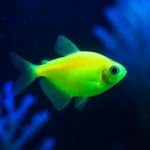
Flying squirrel is a type of squirrel best known for its ability to “fly”. There are about 50 different species of flying squirrel that can be found all around the world. Best known are North American and South American flying squirrel which inhabit north and south part of America and Canada. They can be found in deciduous, coniferous or mixed type of forest. Flying squirrels are not endangered.
They sail from tree to tree on a special membrane between each front and back limb, a trick that has evolved multiple times in history.
Flying squirrel usually reaches 12 inches in length (including the tail) and weighs between 4 and 6.5 ounces.
They evolved big eyes to collect more light for better night vision, an adaptation shared by many nocturnal animals, from owls to lemurs.
Males and females look alike. Fur on their backs and sides is brown to grey, and white on the belly. Tail is flattened and large. It is used as a rudder when they glide through the air.
They can glow at night.
Although they are known as “flying squirrels”, they do not actually fly – they glide through the air. Special type of the furry membrane (called patagia), stretched between wrists and ankles, serves as a parachute which supports squirrel while jumping from tree to tree.
Instead of wings, flying squirrels have ‘patagia’ and wrist spurs.
Flying squirrels can make 180 degree turns during gliding. Longest recorded “flight” was 300 feet, but they normally travel much shorter distances than that. They usually glide between 20 and 30 feet.
Flying squirrels can glide 300 feet and make 180-degree turns.
Flying squirrels use their thick paws as cushion for landing. When they land on the tree, they climb as high as possible to prepare themselves for another jump.
90 percent of all flying squirrel species exist only in Asia.
Flying squirrels are nocturnal (active at night) creatures. Large, bulging eyes help them see in the dark.
Only 3 flying squirrels are native to the New World.
Flying squirrels are omnivores (eat both meat and vegetation). They like to eat different kind of food: slugs, snails, mice, eggs, small birds, mushroom, berries, seed, nuts, tree bark, flowers.
Flying squirrels don’t hibernate, but they do hygge.
Unlike other squirrels, flying squirrels form a single hole in the nut shell to reach the meat inside it. Other squirrels break the whole shell to release the hidden meat.
Some flying squirrels are larger than a house cat.
Flying squirrels do not hibernate, but they slow down their activity during winter. Since the food sources are scarce at that time of the year, they survive mostly by eating food collected during the previous year. Flying squirrels can collect up 15 000 nuts per one season.
The woolly flying squirrel (Eupetaurus cinereus) is known only from about a dozen specimens in the far northern Himalayas, and is deemed endangered by the IUCN due to the clearing of its native pine forests.
Main predators of flying squirrels are raccoons, coyotes, owls, foxes, snakes, birds, cats and dogs.
Flying squirrels are highly social animals. They live in the holes in the trees, such as those made by woodpecker. A large group of squirrels can share a single hole. Squirrels conserve their energy through life in community.
Flying squirrels may share their dens with other animals such as bats and screech owls.
Mating occurs early in the spring and sometimes late in the summer. Flying squirrels usually produce one litter per year.
Gestation period (pregnancy) lasts 40 days and female gives birth of 2 to 7 babies.
Babies are hairless and blind. Their ears are closed and toes are fused. Ears will open after 2 to 6 days. After 6 days, toes will separate from each other. Fur starts to grow after 7 days and their eyes finally open after 24 to 30 days.
Average lifespan of the flying squirrel in the wild is between 4 and 5 years and between 10 and 15 years in the captivity.
Flying Squirrel FAQs:
Flying squirrels are adorable nocturnal creatures that capture our imagination with their gliding abilities. Here are some of the most common questions people search about flying squirrels, answered in detail:
1. Do flying squirrels really fly?
Technically, no. Flying squirrels don’t have wings and cannot sustain true flight. However, they have a unique adaptation called a patagium. This is a loose fold of skin that stretches between their wrist and ankle, creating a furry membrane. When they launch themselves from a tree, they can extend this membrane to “glide” impressive distances through the air.
2. How far can flying squirrels glide?
Flying squirrels are impressive gliders! Depending on the species and launching height, they can glide up to 150 feet (45 meters) or even further in some cases. Imagine gliding the length of a basketball court or even a football field! This exceptional gliding ability allows them to navigate through forests efficiently and escape predators.
3. What do flying squirrels look like?
Flying squirrels are typically small rodents, measuring around 10-12 inches (25-30 cm) in length, with a bushy tail that can be as long as their body. They have large, dark eyes adapted for seeing at night and soft, thick fur that varies in color depending on the species. Most have brown or gray fur with white undersides, but some have reddish tinges.
4. Where do flying squirrels live?
Flying squirrels are found in North America, Europe, and Asia. They prefer forested habitats with mature trees, especially those with cavities or holes that they can use for nesting. They are particularly fond of deciduous and coniferous forests but can also be found in woodlands and even some urban areas with suitable tree cover.
5. What do flying squirrels eat?
Flying squirrels are omnivores, meaning they eat both plants and animals. Their diet varies depending on the season and location, but some common foods include:
- Nuts (acorns, walnuts, hazelnuts)
- Seeds
- Fruits
- Buds and flowers
- Insects
- Spiders
- Occasionally, small birds, eggs, or other invertebrates
6. Are flying squirrels nocturnal?
Yes, flying squirrels are primarily nocturnal creatures. They are most active at night, when they come out to forage for food, glide between trees, and socialize. Their large eyes help them see well in low light conditions.
7. How long do flying squirrels live?
In the wild, flying squirrels typically live for 4-6 years. In captivity, with proper care, they can live up to 10 years. Threats to their survival include habitat loss, predation by owls and hawks, and competition for food and shelter.
8. Can I keep a flying squirrel as a pet?
Flying squirrels are wild animals and not recommended as pets. They have specific needs for space, diet, and social interaction that are difficult to replicate in captivity. In some areas, it’s also illegal to keep them as pets.
9. What are some interesting facts about flying squirrels?
- Flying squirrels can turn mid-glide by using their tail for steering.
- They can also control their gliding speed by adjusting the tautness of the patagium.
- During harsh winters, flying squirrels may enter a state of torpor, where their body temperature and metabolic rate decrease to conserve energy.
- Some species of flying squirrels are known to huddle together for warmth during the winter, sometimes even with other small animals like bats or owls.
10. How can I attract flying squirrels to my backyard?
If you’d like to see flying squirrels in your area, you can create a habitat that attracts them. Here are some tips:
- Plant mature trees with cavities or install nesting boxes.
- Provide a source of food, such as nut feeders or fruit trees.
- Avoid using pesticides or herbicides that could harm their food sources.
Remember, flying squirrels are wild animals and should be observed from a distance. Enjoy watching them glide through the night sky!








